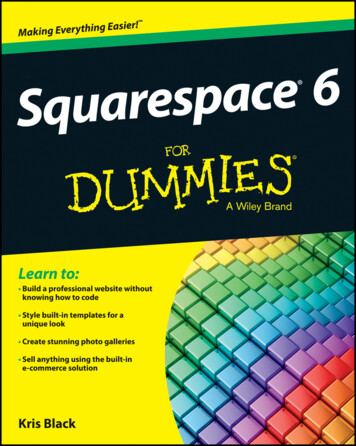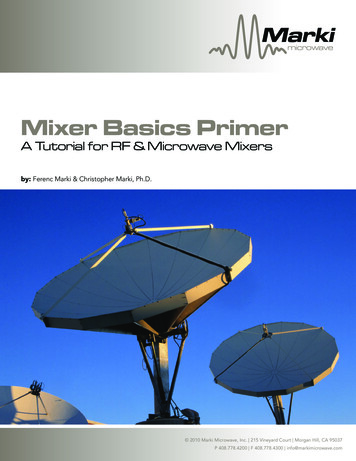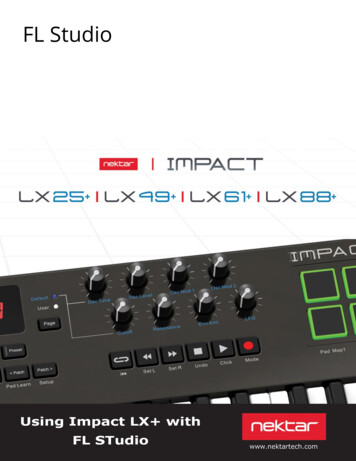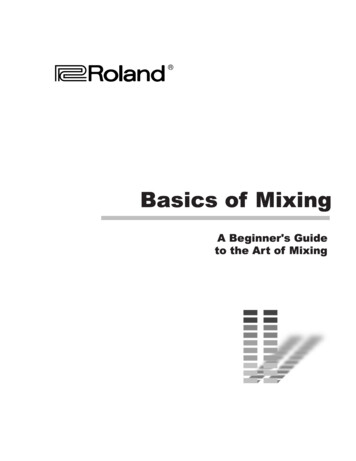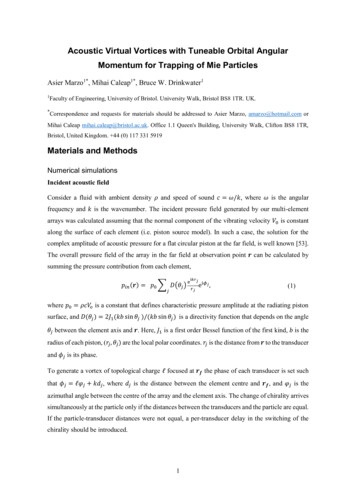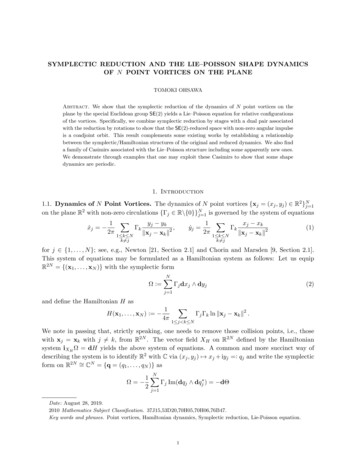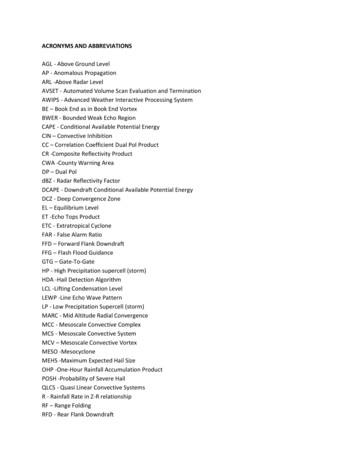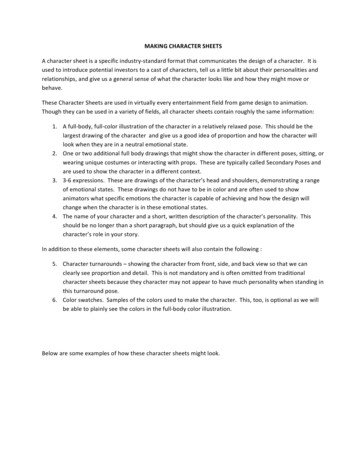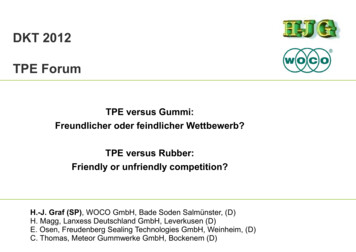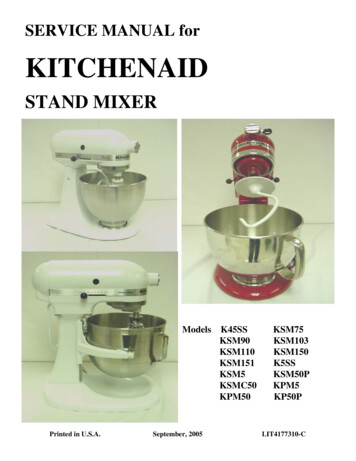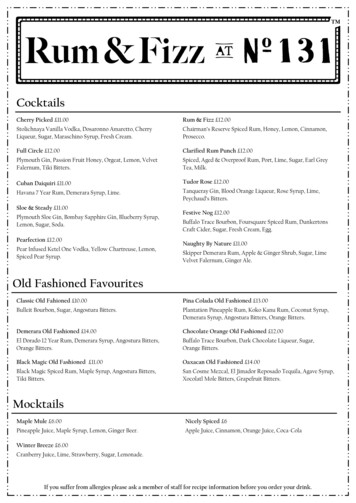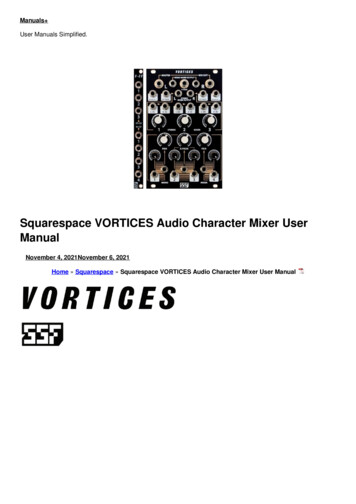
Transcription
Manuals User Manuals Simplified.Squarespace VORTICES Audio Character Mixer UserManualNovember 4, 2021November 6, 2021Home » Squarespace » Squarespace VORTICES Audio Character Mixer User Manual
Contents [ hide1 Overview2 MONO MIXER DETAIL3 QUICK-VIEW: Mono MixerBus4 STEREO MIXER DETAIL5 QUICK-VIEW: Stereo Mix Bus6 AMP BIASING FEATURE7 QUICK-VIEW: V-CV Expander8 DESIGN PHILOSOPHY9 Technical10 Documents / ResourcesOverviewVortices are an audio character mixer designed to emulate and accentuate the saturation-compression effects andfrequency response of vintage analog consoles and tape machines. Featuring a total of 14 inputs and 7 outputs in arelatively compact 16hp form factor (18hp with VCA CV expander).Vortices were designed to offer a compact mixing environment with the characteristic sound coloration of vintageanalog gear. The frequency response of vintage mixing consoles tends to de-emphasize higher frequencies andproduce a rounder tone. I find this to be really nice for reducing harshness from FM’d and digital source material – theresponse makes them sound smoother and less fatiguing on the ear and imposes an inherent glue and polishedsound upon a mix. This type of response also lends itself to feedback patching where higher frequency roll-off isdesired.
The saturation/compression/limiting aspect is inspired in the vein of post-processing a signal from a vintage consoleinto an analog tape machine. Intending to add slight warmth to more extreme saturation-compression. This has a bigeffect on tonality and tends to push the low-mid range while a built-in hard limiting function adds hi-mid crunch in theextremes.Vortices accommodate mono and stereo sources, broken respectively into two mix bus sections, providing separatemix outputs as well as a Master Mix split stereo output and a Master stereo jack output on the back of the module.The separated outputs and auxiliary inputs are provided to accommodate effect chains, feedback patching, and endof chain mixing solutions as well as general sound processing, panning, and crossfading applications.The two mixer sections offer two types of coloration and frequency response. The main Mono Mix channels 1-4provide a warmer over-driven sound with a more pronounced high-frequency reduction and rounder tonality. Higherset gain and input levels pronounce the characteristic saturation-compression effect, thereby beefing up low to midharmonic content. Inputs will eventually hit a hard peak limiter, providing additional distortion at 12Vpp.Auxiliary Mono mix inputs bypass the saturation-compression in exchange for the hard peak limiter (12Vpp) with areduction in high-frequency response. They also apply a -3dB pad to help match nominal levels in a total mix.The direct output for the X-FADE channel s 2 & 3 at the top of Vortices offers the same saturation-compressionwithout the reduced high-frequency response of the MONO MIXER OUTPUTS. (More about the X-FADE breakoutdescribed in the Mono Mixer section.)The main Stereo Mix channels provide a gentler saturation effect and a brighter overall frequency response (whenthe Stereo Mixer bus Output is utilized).These channels can also be driven harder into their respective peak limiters (12Vpp).Auxiliary Stereo mix inputs bypass the saturation-compression in exchange for the hard peak limiter (12Vpp). Theyalso apply a -3dB pad to help match nominal levels in a total mix.The headroom of all final mix outputs is approximately 23Vpp before additional hard clipping of the summed mixesoccurs.MONO MIXER DETAILAUDIO INPUTSThe Mono Mix bus features 4 main mono inputs, each with a level/saturation control via the mini-pots. The nominalvolume level is set between 12-2 O’clock (assuming 10Vpp input) and the saturation-compression level can beincreased beyond this point.Inputs 1 & 4 feature manual and voltage control over stereo panorama (PAN).Inputs 2 & 3 feature manual and voltage-controlled cross-fading (X-FADE).The PAN and X-FADE functions feature unique linear pan/fade laws. Linear laws nominally produce a -6dB dip whenthe relative control is set to the center position. If you are unfamiliar with the decibel scale, this is equal to a gainreduction of 0.5x.Vortices offer a linear law with only a -1.3dB center dip, equal to a gain reduction of approximately 0.86x, animprovement over what even constant power laws can provide.That being said, it is possible to achieve saturation/distortion effects based on pan/fade position, where hard pannedor faded sources will have a slightly higher drive than in center position, without compromising signal volumesubstantially. Use the mini pots to adjust desired max level of volume and saturation.There are two additional auxiliary M-AUX 1 and M-AUX 2 mono inputs to the MONO MIXER near the top of Vorticeson the left and right sides of the module. These are provided for external sources and sub-mixes as well as possiblefeedback patch points. These are monophonic; meaning the signal will sum equally onto both the Left and RightMONO MIXER OUTPUTs.As mentioned previously, a -3dB pad is applied to assist in matching nominal levels of a mix – where it is notexpected that every channel level would be set to maximum, and therefore will not dominate over the other inputs.
AUDIO OUTPUTSThere is a direct output for MONO channels 2 & 3 at the top middle of Vortices labeled X-FADE. Patching out herewill break these channels out of all the associated MIX outputs (MONO MIX and MASTER MIX.) Therefore, you caneither use the crossfading feature separately from the rest of the module or send these channels out for additionalprocessing and back into a Vortices AUX or Stereo Input or into another available Mono input channel for panning,etc.The MONO MIXER output is split stereo to accommodate channel panorama. The LEFT (L) and RIGHT (R) MONOMIXER OUTPUTs are located on either side of the X-FADE breakout jack.PAN & X-FADE CVCV inputs for PAN and X-FADE point to the associated manual controls for each function with golden arrows. Thefaded gold boxes visually connect each Mono Input to the respective CV input and manual control. CV inputs expecta symmetrical /-5V control voltage as standard, however, any signal is permitted without damaging these inputs.QUICK-VIEW: Mono Mixer BusMono Mixer: Audio IN/OUTMain Monophonic Inputs 1, 2 , 3, 4Auxiliary Monophonic Inputs 1 & 2Split Stereo (L/R) Direct Output of the MONO MIXER BusDirect X-FADE output for Channels 2 & 3 (Breaks normalization to all Mix Outputs)
Mono Mixer: ControlsAttenuation, Saturation, and GainChannel 1 & 4 Pan Controls B Golden Arrows pointing from Pan CV InputsChannel 2 & 3 X-FADE Control Golden Arrows pointing from Fade CV InputSTEREO MIXER DETAILAUDIO INPUTSThe Stereo Mix bus features 3 main (L R normalized) stereo input channels with attenuation and gain. Thecoloration offers a less pronounced saturation-compression effect compared to the mono mixer. Nominal level controlis set around 3 O’clock with additional gain available beyond this point.A single split stereo (L R normalized) auxiliary input, located on each respective side of the STEREO MIXEROUTPUT jacks with a -3dB pad is also provided on the Stereo bus to accommodate direct stereo or monophonicsources. Separate mono sources may be used if you would like them to sit directly on the left or right side of the mix.Patching a single mono source into the Left (L) ST-AUX, while the Right (R) ST-AUX is unoccupied will normal thesignal to both sides of the stereo mix.AUDIO OUTPUTSThe STEREO MIXER OUTPUT is located above STEREO channel 2’s inputs. As mentioned previously, this outputoffers a brighter frequency response compared to the MONO and MASTER MIX outputs.MASTER MIXThe MASTER MIX OUT offers the sum of every audio input on Vortices. Split stereo output is located at the far leftand right on the top row. A copy of this signal is also available via a stereo jack on the back of the module. This canbe routed to modules that also utilize a similar rear-facing stereo input.QUICK-VIEW: Stereo Mix BusStereo Mixer: Audio IN/OUT and Controls
Main Stereophonic Inputs 1, 2, 3 (Left to Right Input Normalization)Auxiliary Split Stereo Inputs L & RSplit Stereo (L/R) Direct Output of the STEREO MIXER BusAttenuation, Saturation, and GainAMP BIASING FEATUREThe biasing feature emulates Class-A tube and transistor amplifier tuning. Biasing is a symmetry adjustment that setsthe quiescent operating point of a tube or transistor in order to achieve a linear response with the least distortion. Byincreasing the bias (DC offset) a tube/transistor can be pushed into asymmetrical saturation.While Vortices already provides enough gain to produce saturation/compression on its own, the output is symmetricalas long as the input signal is also completely symmetrical at about 0V. For instance, /-5V is symmetrical while 6V/4V is asymmetrical.The tonality of symmetrical saturation/compression exhibits a dominance of 3rd order (ODD) harmonics. However, ifone half of a waveform saturates more than the opposite half, in an asymmetrical manner, this produces anincreased level of 2nd order (EVEN) harmonics.Vortices can produce asymmetrical saturation/compression when the input source is biased (offset) with a positive ornegative DC voltage. This is accomplished by using an external CV processor or mixer with a voltage offsetadjustment or externally summing an audio source with an envelope or LFO (for a time-varying effect), beforepatching into one of the Vortices’ inputs.If you do not have a free external mixer with or without an offset adjustment, an alternative tonal structure can beachieved by patching an envelope or LFO into an unused channel of the same mix bus on Vortices. In this case, thesignal is clipped by the internal hard limiter and produces crunchier asymmetrical distortion effects.In all amp biasing cases, the total output symmetry remains unaffected and therefore every channel can be biasedwithout pushing the summed mixer outputs beyond the maximum headroom of 23Vpp.
V-CV EXPANDERVortices CV expander adds voltage control of the signal levels for the 3 stereos and 4 mono main inputs.The switch located near the expansion header, between the panel and PCB must be set in the EXP positionwhen the expander is connected.The supplied 10pin cable must be connected in the same orientation on Vortices and V-CV. The red stripe down.With V-CV connected the functioning of Vortices remains the same. Once a Control signal is patched, the respectivechannel attenuator adjusts the level of the incoming CV, allowing level and saturation to be automated. The CVsource should be near 10V for full-scale behavior.QUICK-VIEW: V-CV ExpanderDESIGN PHILOSOPHYIn this section, I will describe my intentions and inspiration for creating Vortices. Particularly in respect to my choice oflayout and features and influences from artists and my own experience in using modular synthesizers.Users often question why module manufacturers choose to make certain design choices. I personally have struggledwith striking a balance between choosing the size and feature set when I design Eurorack modules. When it comesto mixers I have always found it challenging to make choices based on the somewhat standard requirements and therack space they ultimately take up for a relatively basic function. Vortices were designed to capture a list of the most
basic needs of a mixer as well as offer extra use features while taking up a small amount of rack space. Theserequirements included the ability to pan both manually and via voltage control, the ability to cross-fade two sources,and to accommodate both stereo and mono sources including extra inputs. Additionally, I found that I always wanteda way to use a mixer in more of a modular fashion through the ability to separate the mono and stereo sections to usethem as sends while having the option to use either as the main mix output.The second half of the design equation stems from the fact that while extremely useful, mixers are also a somewhatboring necessity. This is where the character aspect comes into play. Some are familiar with my love of analogphilosophy and inspiration from the pro audio world. The use of vintage audio consoles and analog tape for the“magic” they can impose on a mix or instrument is now a widely known phenomenon. Although some have gone togreat lengths to attain these machines for exorbitant prices, the effect is far from snake oil. Here is a great articlefrom Sound on Sound for further reading about how and why vintage analog equipment exhibits this effect in musicproduction.Vortices were designed with intentional gain staging and high-frequency tone shaping to both mimic and accentuatethe effects of over-driving and biasing vintage audio equipment involving tube and transistor circuitry as well as thesaturation-compression effects of magnetic tape in order to highlight the benefits that these devices are so wellsought after for. The ability of vintage analog equipment to glue a mix without the need for compression while addingsubtly to more apparent harmonic content is not restricted to pro audio and fits in quite well in the modular synthesisenvironment. Furthermore, the response of these devices lends heavily to the more modern techniques of feedbackthat have been popularized by artists such as Empyset and are gaining ground in the experimental modularsynthesis microcosm. You can find a discussion of Emptyset’s feedback techniques from the Eurorack communityhere.Inspired by the characteristics of both vintage analog mixing consoles and magnetic tape machines, the concept isrealized in a simulated signal chain where we have a virtual console as our input section, which is then fed into a tapemachine for the final mixdown. Every channel exhibits a simulated headroom. You can think of them as console/tapeinputs that are nearing the headroom limits of those devices and therefore ready to be pushed into saturation andclipping. This effect mimics the physical limits of these vintage devices. Both the Mono and Stereo channels maxheadroom is approximate 12Vpp. This limit is posted input level control and can be tailored to almost any input levelto remain clean if desired. However, we intend that you do push these limits when desired.The headroom limits are met with a hard-peak limiter, not unlike the simple safety limiting devices employed invintage gear. Here you will find another level of distortion with a crunchier hard clipping effect in contrast to the moregeneral, softer saturation compression akin to over-driven analog tape. You will find it much rarer to hit the headroomlimit in typical use unless intentionally overloading the input or applying one of the CV offset techniques described inthe Amp Biasing section. So, you can think of Vortices as a mini vintage studio, a feedback hub, or simply as aneffect or tone shaping device. Although we have focused on the above vintage characteristics, we have opted to skipany emulation of low fidelity effects from these devices and continue to employ the use of pro audio gradecomponents throughout.If you have read some of the above references or are already familiar with the specifics of these saturation andfrequency response characteristics in use, we now point out that the mono and stereo sections of Vortices exhibitalternative severity of these effects. The intention behind this choice is inherent in modules that one may be usingwith Vortices. For instance, it has been described earlier in the manual that the mono and master output sectionsoffer a more intense effect on frequency response, while the stereo output offers a brighter response in this regard. Ithas also been noted that the stereo section’s saturation effect is more subtle.The intention here is that you would use the mono section to add varying levels of saturation, add panning and crossfading then patch from the Mono Mix Output to stereo effects such as delays, reverb, or resonators. Since theseeffects do tend to be stereo and can also tend to be darker in tone, the stereo section is meant to accommodatethese aspects while still adding a bit of warmth and roundness to the overall response. This is a case where youwould choose to use the Stereo Mix Output as your main mix-out. In general, the stereo section and output may beused for sources in which you do not need to add as much saturation or distortion or would like that particular input tohave a stronger high-frequency presence.The high-frequency response and intensity of saturation achievable from the mono section offer additional usesspecific to modular synthesis. For instance, we are all familiar with frequency and amplitude modulation for producingmore complex sounds. These basic techniques are widely utilized for creating sideband frequencies beyond thefundamentals that standard VCO waveforms can produce. Unfortunately, they can also create grittier overtones inthe higher harmonic region and can sound harsh and piercing.
The Mono Mixer channels can smooth FM’d material and round out the edginess of sharp transients. Because ourears will perceive higher frequencies in this manner, and signal sources do not generally have built-in frequencycompensation in this part of the audio band, the only way to tame the imbalance would traditionally be to use a filter.While a simple solution, it may not be practical to use up a VCF for such a simple function. Vortices offer a way toaccomplish this automatically in a mix. Another similar and common situation occurs when using digital sources.There are many very good-sounding digital modules but even the great ones can sound sterile or exhibit somealiasing. Both the frequency response and saturation can be used to smooth and add analog warmth to thesesources.While on the subject of high frequencies, it is also important to have a handle on this part of the audio spectrum in afeedback application. Vortices lend themselves to even simple self-feedback patching without the need for additionalmodules to tame the high end. High-end frequencies will start to feedback much more easily than lower ones. Itbecomes more difficult to manage a feedback patch when the high end is constantly on the brink of oscillation. Youcan choose a number of feedback topologies that focus on either the mono or stereo mixers with mindfulness of yourchosen source material and how frequencies and external modules may affect your patch.The Amp Biasing Feature mentioned earlier in the manual may be familiar to an engineer or tech in the audio world,but unknown to many synth users. This is an essential aspect of any discrete amplifier and a feature exploited by thetechnical counterparts of many famous artists as well as savvy audio engineers who desired to perfect or modify adevice to attain ‘that sound’.We have touched on this feature in the Amp Biasing section where we described biasing as a necessary feature ofcalibrating a tube or transistor amplifier to work correctly, in order to produce a clean and linear response. Vortices’implementation of this feature is 100% on the level of exploitation of the harmonic effects it can produce. If you donot choose to offset the input signal before patching into Vortices, and your signal is symmetrical about ground (ZeroVolts), then the effect is simply the same as a properly biased amplifier, with the exception that you can increase thedrive to overdrive the input into heavier saturation and clipping. When pushed into this region, the top and bottomhalves of the input signal both have to potential to exhibit the same effect on the input waveform (symmetricaldistortion.)When a signal distorts symmetrically, additional Odd Order harmonics are produced, specifically third-order up fromthe fundamental frequency dominates, with the successive 5th, 7th harmonics appearing in reduced amplitude. OddHarmonics are known to have enharmonic qualities. One example of this would be a square wave, which consists ofa summation of only odd-order frequencies. See the Fourier Analysis section of this wiki article if you are unfamiliarwith this concept. We also see this happening on an oscilloscope when we add a lot of gain to a sine or trianglewaveform as we add to gain the signal begins to clip and look more and more like a square wave. We also hear theadditional odd harmonics produced as the signal becomes increasingly square-shaped.But we digress, the alternative to this symmetrical distortion and production of enharmonic overtones is to have theability to asymmetrically distort a signal in order to enlist a dominance of Even Order, more musical sounding 2nd,4th, and 6th harmonic overtones. This is where some of the intentional or rather sometimes unintentional parametersof vintage audio impart the magical effects we have exploited. So, by adding a DC offset to an input signal, we canemulate the ability to produce sweeter and more musical-sounding harmonics when distortion is applied. This effectcomes without the disadvantage of allowing this offset to either physically offset the input signal within the mix, orsum into the final output of the mix itself. This means that any signal that has a bias offset applied will alwaysphysically remain symmetrical about the ground, while the asymmetrical clipping effects remain intact.Thank you for choosing to include Vortices in your modular system. It is my hope that this section offered you someinsight into the design intention and has inspired you to use Vortices creatively and sparked some ideas for you toexperiment with. Thank you for your support.TechnicalVortices:Power Consumption: 110mA, -105mAWidth: 16hp Depth: 26mmV-CV:Power Consumption: 0mA, -0mAWidth: 2hp
Depth: 23mmDocuments / ResourcesSquarespace VORTICES Audio Character Mixer [pdf] User ManualVORTICES, Audio, Character, Mixer, VCA, CV, expanderManuals ,homeprivacy
Manual November 4, 2021November 6, 2021 Home » Squarespace » Squarespace VORTICES Audio Character Mixer User Manual. Contents [ hide 1 Overview 2 MONO MIXER DETAIL 3 QUICK-VIEW: Mono Mixer Bus 4 STEREO MIXER DETAIL 5 QUICK-VIEW: Stereo Mix Bus 6 AMP BIASING FEATURE 7 QUICK-VIEW: V-CV Expander
